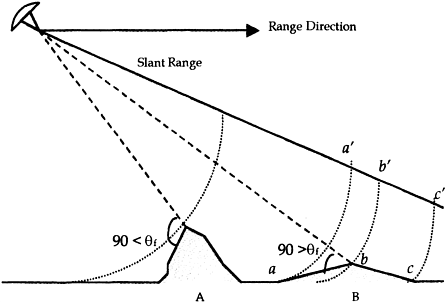225.
| [Cover] [Contents] [Index] |
Page 30

Figure 1.16 The angle θf controls layover effects (see text for discussion).
brighter, steeper and shorter, while the back slope is shallower and darker. The darker back slope demonstrates another radar image geometry effect, that of shadow, as illustrated below.
‘Radar shadow’ is due to the returned back energy from targets being affected by the nature of the terrain. A radar image is effectively a representation of returned energy levels plotted against the time taken for the energy to travel to and from the target. It follows that if, during a certain period, the antenna receives no reflection then the image area corresponding to this time period will contain zero (dark) values.
The effect of radar shadow is controlled by the target height and angle θb (Figure 1.17), which is defined as the angle between the back slope of the target and the horizontal line parallel to the range direction. In Figure 1.17, the angle θb of object A is smaller than the corresponding depression angle θ1. Thus, the back slope of object A is illuminated by the microwave energy. However, since the angle θb of object B is larger than the corresponding depression angle θ2, the radar antenna will not receive any reflection from the back slope of object B, and this period of zero reflection is likely to continue until point a is reached. The resulting radar shadow after projection on to slant range is also illustrated in Figure 1.17.
The description of radar image distortions given above is a simplification. In real-world applications where terrains are often continuously sloping and rapidly varying, the resulting image will be a combination of different geometric effects. Hence, in order to compensate these effects, one has to make careful case-by-case analyses (Kropatsch and Strobl, 1990). That is,
| [Cover] [Contents] [Index] |
EAN: 2147483647
Pages: 354